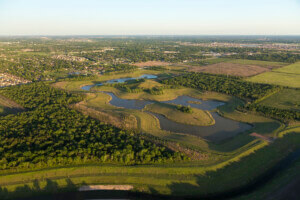Houston’s green renaissance set the stage for a recent conference of landscape architects, designers, planners, institutional leaders, and policy makers who convened at the Museum of Fine Arts Houston on March 11.
Hosted by Washington, D.C.–based non-profit The Cultural Landscape Foundation (TCLF), Leading with Landscape II: The Houston Transformation focused on how landscape architecture is changing the city at a scale not seen in the U.S. in a century.
Charles Birnbaum, founder and executive director of TCLF, posited Houston’s built heritage in three sections: The linear hardscape and engineering of freeways,
the iconic architectural monuments connected by said infrastructure, and today’s emerging landscape architecture that is stitching together the natural and built environments.
“The story of zoning and planning in Houston is a fascinating study, one that lies at the very center of the conference and tours. It is a story characterized by political wrangling, economic boom and bust cycles, hurricane and flooding, the influence of the automobile in infrastructure and housing development, public-private partnerships, and the presence of the many bayous that traverse the city,” Birnbaum wrote in the conference guide. “Houston provokes the question, ‘Can a city that has developed largely without a plan also be one that is leading with landscape?’”
Conference discussions looked ahead to the ambitious new plans for Bayou Greenways, Memorial Park, the Menil’s Campus, and the Houston Botanic Garden, while examining the successes of Discovery Green and Hermann Park. Issues of street-level design for pedestrian experiences, equity, inclusion, and funding were also brought to the forefront to improve upon the city’s connectivity and accessibility.
The daylong panel discussions included the voices of leading landscape architecture firms and various institutions: SWA, Michael Van Valkenburgh Associates, West 8, Hargreaves Associates, the Office of James Burnett, Reed Hilderbrand, Design Workshop, Nelson Byrd Woltz Landscape Architects, Asakura Robinson, Clark Condon, the Hermann Park Conservancy, the Kinder Institute for Urban Research at Rice University, the Houston Chronicle, the Kinder Foundation, Chilton Capital Management, Clean Line Energy, the School of Architecture at the University of Texas at Austin, the Houston Parks and Recreation Department, Rice University, the University of Houston, and the Anchorage Foundation of Texas. San Antonio mayor Ivy Taylor and former Houston mayor Annise Parker also spoke during the final session titled, “An Appraisal.”
Taylor, an urban planner originally from Queens, spoke about parks as potential anchors for neighborhoods, including San Antonio’s redevelopment of the Riverwalk, Pearl Brewery, and drainage improvements, as well as matters of park equity. She cited having grown up near Central Park in New York, “the granddaddy of them all.”
“As a little girl, I didn’t go to those parks. We had a square patch of grass. How do we reach out to folks to experience the natural environment?” Taylor asked. Her presentation led to the question: How are we to be stewards for the next generation?
The foundation also hosted expert-led free tours March 12–13 at more than 30 iconic sites that demonstrate Houston’s legacy of green and public spaces, including Buffalo Bayou Park, Sesquicentennial Park, the Menil’s Campus, Gerald D. Hines Waterwall Park, Sabine Promenade, and Discovery Green.
“This is my city. I love this city,” Parker said. “This is a city of big ideas and we tackle big things in big ways.” She continued to discuss the importance of the Port of Houston, the Astrodome, “Houston” as the first word on the moon, and issues including infrastructure, parks, preservation, and public art. She also elaborated on the Bayou Greenways Initiative and how it touches every community in Houston by creating an interconnected green web. As great cities attract intellectual capital, it also needs amenities and attractions for its citizens.










